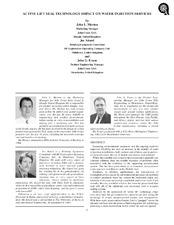| dc.description.abstract | Increasing environmental awareness and the ongoing need for improved reliability has seen an increase in the number of water reinjection installations, both onshore and offshore, and in particular in recent years, the use of double pressurized seal solutions. While these double seal solutions have presented a generally satisfactory solution, there are notable instances of problems often associated with the reliability of the supporting pressurization system. This has been particularly so in formation and produced water injection installations in the Middle East. Similarly, in offshore applications, the introduction of comingled service caused by environmental pressures on operators to reinject produced water has caused the traditional single seal solutions to become increasingly unreliable and to lose favor. Until recently, the only available solution has been the pressurized dual seal with all of the additional cost associated with a complex sealing system. However, by the application of “active lift” technology, originally developed for gas compressors, operators are now seeing the advantage of simple nonpressurized tandem seal arrangements. With these seals, unpressurized barrier fluid is “pumped” across the inboard seal faces into the process fluid using active lift technology, providing a clean environment within which the seal can operate. These active lift seals have now been developed and applied to a level whereby suction pressures of 70 bar/1000 psi and beyond can be handled, providing all of the benefits of a pressurized dual seal, without the complexity and cost of pressurized solution. While active lift technology has been applied to pumps for several years, it has traditionally been associated with low pressure environments. Advances in active lift characteristics have now allowed the technology to be applied on increasingly demanding applications, eliminating the need for complex seal support systems. | en |


